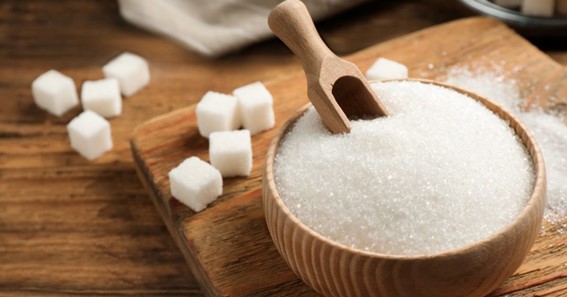Almost everyone consumes sugar but not everyone knows the density of sugar. Here I will tell you the sugar density and also teach you how to calculate it. Sugar is white-colored, sweet-tasting, soluble carbohydrates, and a granular form of sucrose commonly used in food. Sugar is a sweetener but it has a bittersweet reputation when it comes to health. Sugar occurs naturally in all foods that contain carbohydrates, such as fruits and vegetables, grains, and dairy. Consuming whole foods that contain natural sugar is okay. Plant foods also have high amounts of fibre, essential minerals, and antioxidants, and dairy foods contain protein and calcium. Let’s come back to the density of sugar.
What Is The Density Of Sugar?
The density of sugar is 1.59 g/cm3. It has a chemical formula of C12H22O11 and its molecular weight is 342.296 grams per mole. The density of table sugar is also 1.59 g/cm3 and it is called sucrose. As you all know, sugar is completely soluble in water, and when it dissolves in water its density changes. And the density of sugar water is 1.06 grams per millilitre. Similarly, the density of sugar solution is 1.59 g/cm3.
There are two types of sugar, namely white sugar and brown sugar. Now, you know about shite sugar density, so, the brown sugar density is 1.5 g/cm3. Sugar is naturally made up of sugarcane and the density of sugarcane juice is between 1044.5 and 1189.5 kg/m3. Let me tell you the sugar density in other units.
The density of sugar in g/cm3 is 1.59 g/cm3The density of sugar in kg/m3 is 1600 kg/m3, the density of sugar g/ml is 1.59 g/ml, and the density of sugar kg/l is 845.35 kg/l.
Read continuously, to know about the definition of sugar density.
Click here – What Is Charlie Watts Cause Of Death?
Definition Of Density Of Sugar
Sugar density is defined as the total space occupied by the sugar or the mass of the sugar divided by the volume of the sugar. The sugar density is directly proportional to the mass of sugar and inversely proportional to the volume of the sugar. Also, the sugar density is dependent on the temperature and pressure. The density of sugar syrup is kg/m3 is 1333 kg/m3. When you put sugar into water, then you observe that the sugar settles down at the bottom of salt water. So, the density of sugar vs salt water tells us that sugar is denser than salt water. The formula for the sugar density,
The density of sugar is = Mass of the sugar volume of the sugar g/cm3
Or
D = m v g/cm3
Where, d is the density of sugar
m is the mass of sugar, and
v is the volume of the sugar
You know the density of sugar kg/m3 as well as the density of sugar in g/cm3 now lets see the calculation.
How To Calculate Density Of Sugar?
Calculating the sugar density is very simple and easy. Let’s calculate the sugar density.
- First of all, take sugar and measure its weight.
- Now, measure the volume of sugar and measure it using the water displacement method.
- Divide the mass by volume, and you will get the sugar density.
Let’s understand with the help of an example.
100 grams of sugar with 60 cm3 volume. Find the sugar density.
So, by using the formula,
The density of sugar is = Mass of the sugar volume of the sugar g/cm3
= 100/60
= 1.66 g/cm3
So, the sugar density is 1.66 g/cm3.
For more information like this visit Wejii
Click here – What Are Solar Energy Pros And Cons?
FAQ
Is Sugar Denser Than Water?
Densities of Some Common Substances
Thus 2 ml of water has a mass of 2 g etc. Table sugar is more dense than water by about 60 percent.
What Is Bulk Density Of Sugar?
Bulk density: 625-1,000 kg/m3
Which One Is Heavier Sugar Or Salt?
Here’s why: Salt is about 25% more dense than sugar. Therefore a teaspoon of salt weighs more than a teaspoon of sugar by almost 25%.
What Is The Density Of Sugar In G Ml?
The density of table sugar is 1.59 g/mL.
How Do You Calculate Sugar Density?
Divide the mass of the sugar water by its volume to determine its density. The calculation for the example looks like this: Density of sugar water = 53 grams / 50 milliliters = 1.06 grams per milliliter.
What Is A Unit To Measure Density Of Sugar?
Degrees Brix (symbol °Bx) is a measure of the dissolved solids in a liquid, and is commonly used to measure dissolved sugar content of an aqueous solution. One degree Brix is 1 gram of sucrose in 100 grams of solution and represents the strength of the solution as percentage by mass.
Conclusion
After reading this article you come to know that the sugar density is 1.59 g/cm3. As well as you also know the density of sugar solutions. Nowadays, the consumption as well as production of sugar has increased and it has adverse effects on human health. Consuming too much sugar affects your heart and High sugar diet and a greater risk of dying from heart diseases. According to professionals, 24 teaspoons of added sugar per day is too much. So, this was all about the density of sugar.
What is the density of sugar in kg m3
What is the density of sugar?
